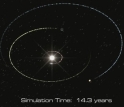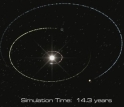News Release 05-057
A Planetary Family Feud
Simulations suggest that the system still bears scars

An artist's rendition of the Upsilon Andromedae planetary system.
April 14, 2005
This material is available primarily for archival purposes. Telephone numbers or other contact information may be out of date; please see current contact information at media contacts.
Planets are thought to be common in the universe. But planetary systems that can harbor life may well be the exception, rather than the rule. According to a study funded by the National Science Foundation and published in today's issue of the journal Nature, it's just too easy for them to engage in the kind of family strife that makes life impossible.
Our own solar system is actually pretty harmonious by cosmic standards, explains the study's principal investigator, Northwestern University physicist Frederic A. Rasio. One big reason why Earth can support life is that our planet has had liquid oceans and a comparatively constant climate for billions of years now. And one big reason it's been able to maintain that constancy is that Earth and all the other major planets of our solar system have spent those billions of years in stable, near-circular orbits around the Sun.
But over the past decade, says Rasio, more than 160 planets have been identified in orbit around other stars, with new ones being found all the time. And most of those extrasolar planets are giant, Jupiter-sized bodies that follow elongated elliptical orbits around their parent stars. In the process, presumably, their gravity has badly stirred up the orbits of any smaller, Earth-like planets, which would seem to make stable oceans and climates out of the question.
In their new study, Rasio and his colleagues from Northwestern and the University of California, Berkeley, suggest an explanation for how these systems got into such a state. By combining observational data with computer simulations of the multi-planet system Upsilon Andromedae, the researchers have traced its current configuration back to an earlier episode when one planet wandered too close to its siblings. The result was a very quick but fierce period of orbital turmoil that ended with the offending planet being ejected into interstellar space. The remaining planets settled into relative peace, but with orbital patterns that retain the scars of childhood family dysfunction to this day.
For more information see the news releases from Northwestern University and the University of California, Berkeley.
-NSF-
-
An artist's rendition of the Upsilon Andromedae system.
Credit and Larger Version -
View Video
Family Feud at Upsilon Andromedae: Streaming Version
Credit and Larger Version -
View Video
Upsilon Andromedae animation: Broadcast Quality Version
Credit and Larger Version
Media Contacts
Megan Fellman, Northwestern University, (847) 491-3115, email: fellman@northwestern.edu
M. Mitchell Waldrop, NSF, (703) 292-7752, email: mwaldrop@nsf.gov
Principal Investigators
Frederic A. Rasio, Northwestern University, (847) 467 3419, email: rasio@northwestern.edu
Related Websites
Preprint of Upsilon Andromedae paper: http://xxx.arxiv.cornell.edu/abs/astro-ph/0502441
Artist's conceptions and a broadcast-quality animation of the Upsilon Andromedae system: http://www.astro.northwestern.edu/rasio/UpsAndPR/
The U.S. National Science Foundation propels the nation forward by advancing fundamental research in all fields of science and engineering. NSF supports research and people by providing facilities, instruments and funding to support their ingenuity and sustain the U.S. as a global leader in research and innovation. With a fiscal year 2023 budget of $9.5 billion, NSF funds reach all 50 states through grants to nearly 2,000 colleges, universities and institutions. Each year, NSF receives more than 40,000 competitive proposals and makes about 11,000 new awards. Those awards include support for cooperative research with industry, Arctic and Antarctic research and operations, and U.S. participation in international scientific efforts.
Connect with us online
NSF website: nsf.gov
NSF News: nsf.gov/news
For News Media: nsf.gov/news/newsroom
Statistics: nsf.gov/statistics/
Awards database: nsf.gov/awardsearch/
Follow us on social
Twitter: twitter.com/NSF
Facebook: facebook.com/US.NSF
Instagram: instagram.com/nsfgov





